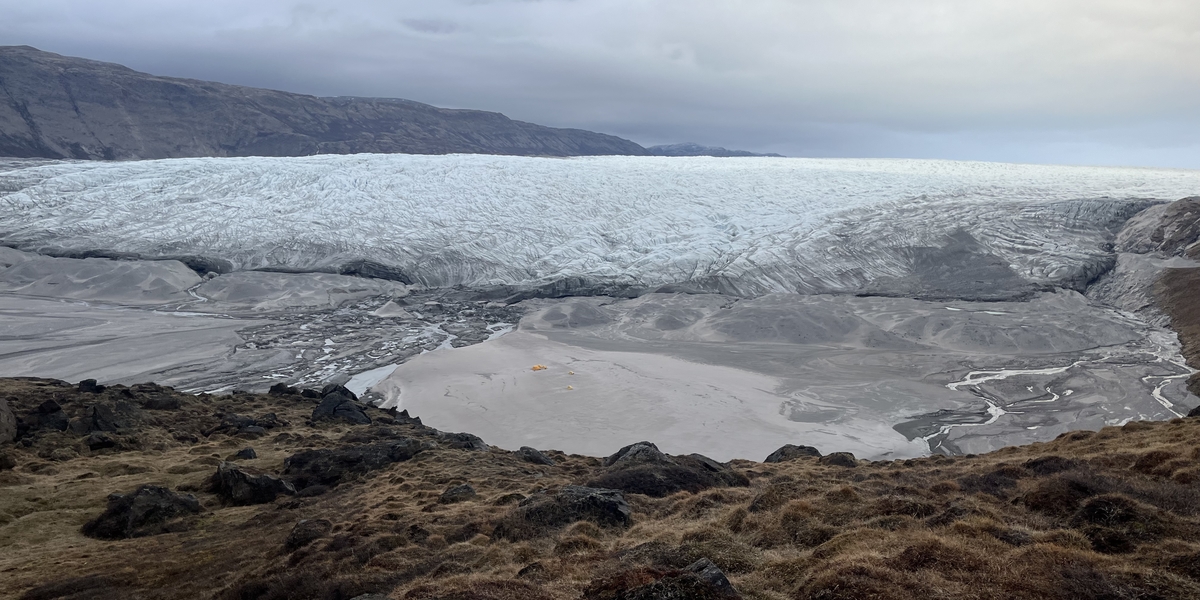
Chris Hansen joined Trinity Hamilton’s “Fringe” Lab as a Plant and Microbial Biology graduate student knowing he’d be making regular trips to Greenland for research. There, the Fringe Lab is broadly interested in characterizing the mysterious microbial ecosystems of Greenland’s receding glaciers. Pools of glacial melt at the terminus of Greenland’s ice sheets could hold clues as to what life underneath glaciers is like–and what the receding of Arctic glaciers could mean for our planet’s future. Fresh from the field, Hansen shares what it’s like to witness the immense scale and wonder of these glacial environments.
Can you tell me a little about what got you interested in microbial biology?
For undergrad, I went to the University of Oregon. I wanted to be in medicine for the longest time. Then I switched to evolutionary biology and worked with nematodes–worm evolution. And then one of the last classes I took was microbiology. And man, it was so fun. Microbiology really stood out–seeing life at a different scale, complexity, and applying unique physiologies to thrive in extremes gripped me. But when I graduated, I was torn between environmental law and exploring microorganisms further. In the interim, I worked in a hotel for a couple of years, navigated sales briefly, and found my niche in project management.
Then COVID provided an opportunity to reassess and say, ‘You know what, let’s see this passion in microbiology come to fruition!’ And that's when I joined the Masters of Biological Sciences program here in Minnesota. I was captivated by the intersection of microbes, geochemistry, and nutrient cycling throughout glacial ecosystems in Trinity Hamilton's class. One thing led to another and I ended up being very fortunate to join her lab as a Master's student, and now a Ph.D. student.
Could you describe what your Greenland research?
As the seasons change, the dynamics of meltwater within the Greenland ice sheet change as well. So during the summer, a lot of melting happens from the surface, so water falls through the glacier ice. It’s eventually exported downstream where the glaciers terminate. During the winter, there’s also melting that happens beneath the glacier. For our specific research, we're hoping to take advantage of these small pools of glacier melt that bubble year round (except during the winter when they freeze). These pools are water that's being flushed from beneath the glacier and popping up. So they're kind of a unique occurrence.
By looking at these pools, we hope to get some insight into what's happening beneath these glaciers– what kind of resources are limited? Are there not a lot of gasses? Are there not a lot of sediments that are available? What is the type of bedrock due to the type of microbes that are there? And then what are these microbes doing? What are they eating? And how might that affect what kind of nutrients are being cycled prior to export throughout the entire year?
How might you explain the relevance of your research to someone who’s not a scientist?
I think it's two different things. The first is the exploratory aspect. We're filling in gaps and trying to understand what happens beneath the Greenland ice sheet. A lot of the ice sheet is never exposed to melting, so we're kind of revealing this alien environment that is challenging to explore. It sheds light on new processes that may be happening beneath the glaciers, new metabolisms that microbes are using.
Secondly, glacial retreat is advancing. The Greenland ice sheet is going to disappear eventually. And in addition to having dramatic consequences for sea level rise that’s going to be devastating for coastal communities, it’s going to have impacts on ecosystems, like what ecosystems are doing, what kind of nutrients are available. What's going to happen when we lose the services that they provide or new habitats emerge sans glacier-cover?
So it's exploratory, which I love. But I also love how it could potentially help predict what's going to happen once these glacier systems disappear.
Any impactful takeaways from your time there?
The coolest thing was witnessing the dynamic features and scale of glacier outlets adjacent to the Greenland Ice Sheet. The vibrant, alien blue color and complex, flowing, crevasse-laden formations took my breath away. The scale of these environments are wild–they stretch far past the horizon. The ice sheet ice is constantly moving and transporting ancient bedrock sediments across the continent. It’s extremely humbling. Losing this ice-cover will dramatically change our world, though I have an opportunity through my research to explore these threatened places and (hopefully) preserve a record of them in some way. It was also very rewarding speaking with Greenlandic locals and learning more about their knowledge of temporal changes to the area, native words for our sampling sites and ice-structures of interest and way of life near arctic fjords.
Aside from that, I discovered that field research is a blast, but challenging as well. I love the adventure of executing sampling game-plans, but hurdles are inevitable and melting conditions at the toe of Isunnguata Sermia (or glacier of interest) are hard to predict. In addition, the cold and glacier-driven winds are a slap in the face, fingers and toes at times. Enduring these challenges, pivoting to sample newly-revealed water bodies, troubleshooting approaches with incredible team members, and taking a step back to acknowledge how amazing the Greenland Ice Sheet is allowed me to be proud of our fieldwork and eagerly anticipate our next trip. Mistakes will totally be made, but we always learn during fieldwork and create incredible bonds along the way.